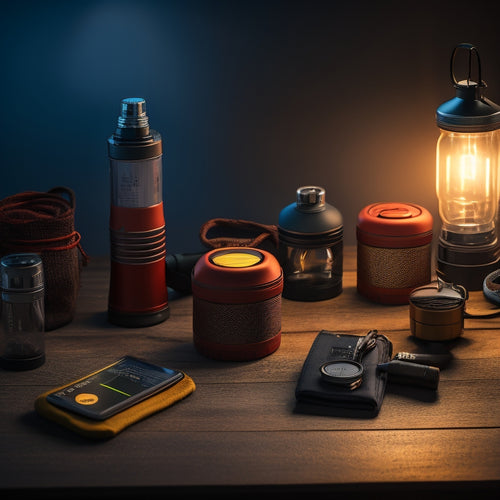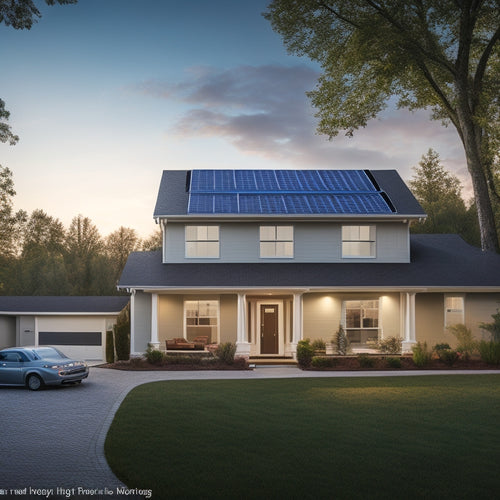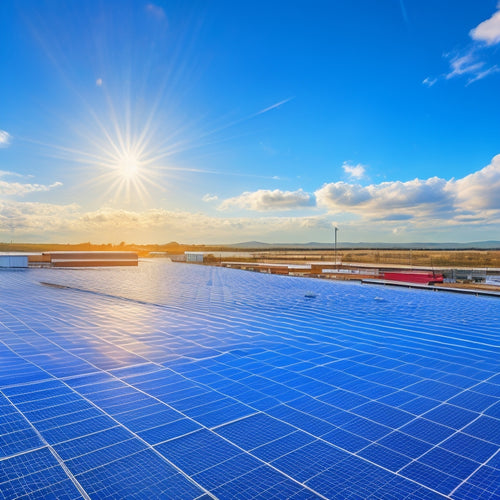
Clean Solar Panels for More Energy Output
Share
You can increase your solar panel energy output by up to 25% simply by cleaning them regularly. Dust and dirt accumulating on your panels can greatly reduce their energy harvesting efficiency, making maintenance an essential step in maximizing your investment. By keeping your panels clean, you facilitate better photon penetration, enhancing your energy output and reducing your reliance on the grid. Proper cleaning also extends the lifespan of your solar panels and reduces hotspots. Now, take the next step to optimize your solar energy system's performance.
At a Glance
- Cleaning solar panels can increase energy output by up to 25% by removing dirt and debris that block sunlight.
- Regular cleaning prevents hotspots, extends panel lifespan, and reduces reliance on the grid and carbon footprint.
- Clean panels facilitate better photon penetration, increasing energy output and reducing electricity bills.
- Dust repellent surfaces and hydrophobic coatings minimize maintenance needs, reduce water spots, and enhance overall efficiency.
- Micro-cells with self-cleaning technology reduce dust accumulation, allowing for more efficient cleaning and higher energy output per unit area.
Maximize Energy per Hour
You can greatly impact your solar panel's energy production by understanding how to maximize energy per hour. This requires optimizing your system's peak sun hour output, which is the amount of energy your panels produce during the sunniest part of the day.
For instance, photovoltaic cell technology plays an essential role in efficient energy conversion, and by improving this technology, you can increase your energy output.
Peak Sun Hour Output
Maximize energy output by utilizing peak sun hours, the period when the sun's rays strike the Earth most intensely. During this time, the sun's rays have the highest solar irradiance, resulting in maximum energy output from your solar panels.
You can take advantage of peak sun hours by positioning your solar panels at the ideal angle to receive direct sunlight. Additionally, investing in a reliable home battery storage solution can help you store excess energy generated during peak sun hours, allowing you to use it during off-peak hours or emergencies.
Typically, peak sun hours occur between 9 am and 3 pm, depending on your location and time of year. Weather impacts, such as cloud cover and haze, can reduce the intensity of the sun's rays, decreasing energy output. However, even on cloudy days, some solar irradiance still reaches the Earth's surface.
Energy Harvesting Efficiency
Cleaning your solar panels regularly guarantees peak energy harvesting during prime sun hours. When you maintain your solar panels, you're ensuring that every photon hitting the panel is converted into usable energy. This is vital for maximizing energy output per hour, especially during peak sun hours when energy demand is high.
By integrating a battery storage system into your solar setup, you'll reveal the full potential of renewable energy and create a more sustainable, dependable, and cost-effective power solution Solar Energy Storage Solutions.
A clean solar panel can produce up to 25% more energy than a dirty one. This translates to significant savings on your energy bills and a reduced carbon footprint. Furthermore, regular maintenance helps prevent hotspots, which can reduce the lifespan of your solar panels.
To optimize energy output, it's important to clean your solar panels every 6-12 months, depending on your location and environmental conditions. You can use a soft-bristled brush, mild soap, and distilled water to remove dirt and debris.
Additionally, consider investing in a solar panel cleaning system that uses a water-free cleaning solution to minimize water waste. By prioritizing solar panel maintenance, you'll be able to maximize your energy output and enjoy the freedom that comes with relying on clean, renewable energy.
Boosts Panel Efficiency Rate
You'll notice a significant energy gain when you clean your solar panels, resulting in an enhanced energy output. This is because clean panels allow photons to penetrate more efficiently, converting sunlight into usable energy.
High-efficiency solar panels, such as those from top solar panel efficiency, can maximize energy harvesting and lower your bills. By removing dirt and debris, you can improve your panel's efficiency rate, ensuring you generate the most power possible.
Energy Gain Boosted
By utilizing the full potential of their solar panels, homeowners can reap significant benefits, including increased energy production and lower electricity bills. This is because clean solar panels can generate more electricity than dirty ones, resulting in greater energy output.
When you maintain your solar panels through regular cleaning, you can expect an energy gain enhancement of up to 25%. This translates to more power for your home and reduced reliance on the grid.
To achieve this enhancement, it's crucial to prioritize solar maintenance. A cleaning frequency of every 6-12 months is recommended, depending on your location and climate.
During this process, dirt, dust, and debris are removed, allowing your panels to operate at their maximum capacity. By doing so, you'll be able to utilize the full power of the sun, reducing your energy costs and carbon footprint.
With clean solar panels, you'll be one step closer to achieving energy independence and reaping the rewards of renewable energy.
Efficiency Rate Improvement
Step up your solar panel's performance with a thorough cleaning, and watch its efficiency rate soar. A clean solar panel can increase its energy output by up to 25%, making it an essential aspect of solar panel maintenance.
When dirt, grime, and other debris accumulate on the surface, they block sunlight from reaching the photovoltaic cells, reducing energy production. By implementing effective cleaning techniques, you can guarantee peak energy output.
Regular cleaning can improve your solar panel's efficiency rate by reducing the angle of incidence, which increases energy absorption. Additionally, cleaning helps prevent hotspots that can reduce panel lifespan.
To maximize efficiency, clean your solar panels every 6-12 months, depending on environmental factors such as dust, pollution, and rainfall. Use a soft-bristled brush, mild soap, and deionized water to avoid damaging the panels.
Micro-Cells for Efficient Cleaning
When you're designing micro-cells for efficient cleaning, you'll find that cell size matters - smaller cells allow for more effective cleaning and reduced dust accumulation.
This is particularly important for off-grid battery solutions, where reliable energy supply is essential.
You'll also want to take into account dust repellent surfaces, which can greatly minimize the amount of dirt and debris that settles on the panels.
Cell Size Matters
Your solar panel's photovoltaic cells, resembling a grid of tiny squares, are the backbone of its energy-harvesting capabilities. These cells convert sunlight into electricity, making them the most vital component of your solar panel.
When it comes to cell optimization, size comparison is essential. Larger cells may seem more efficient, but they're often more prone to damage from debris and dirt accumulation.
In contrast, smaller cells, often referred to as micro-cells, offer several advantages. Their smaller size allows for more efficient cleaning, reducing the impact of dirt and debris on energy output.
Additionally, micro-cells can be designed with a higher packing density, increasing the overall energy output per unit area. This results in a more efficient use of space, making them ideal for smaller installations or applications where space is limited.
Dust Repellent Surfaces
Micro-cells' higher packing density and smaller size make them more efficient, but it's their dust repellent surfaces that truly set them apart.
These surfaces are designed with self-cleaning technology in mind, allowing them to repel dust and debris more effectively. You'll notice that micro-cells are often coated with hydrophobic materials, which creates a water-repellent surface. This means that when it rains, the water will roll right off, taking dirt and dust with it.
The result is a significant reduction in maintenance and cleaning requirements.
With traditional solar panels, you'd need to regularly clean them to maintain peak energy output. But with micro-cells, you can enjoy the freedom of generating clean energy without the hassle.
The hydrophobic coatings also reduce the risk of water spots and mineral deposits, which can further impede energy output.
Consider Panel Size Compatibility
When selecting a cleaning system for your solar panels, you'll need to take into account the panel size options available to guarantee compatibility.
You'll want to choose a system that can accommodate your specific panel size, whether it's a standard 60-cell or larger 72-cell panel.
When setting up your solar panel system, it's vital to confirm a safe and efficient connection to the grid, using an easy connection kit to simplify the process.
Additionally, proper solar panel wiring and setup are fundamental to maximize energy output.
Additionally, you'll need to verify the cleaning system is compatible with your existing racking system to facilitate smooth installation and operation.
Panel Size Options
As solar panel installations become increasingly popular, considering panel size options is vital to confirm compatibility with your existing system. You need to make certain that the new panels fit seamlessly with your current setup to avoid any disruptions or losses in energy output.
When selecting panel size options, you'll encounter various size variations. Standard panel dimensions range from 39 inches wide to 65 inches long, with powers ranging from 250 to 400 watts. However, some manufacturers offer larger or smaller panels to cater to specific needs. You may come across panels with dimensions like 41.5 inches wide and 67 inches long, or even more compact designs for residential installations.
It's important to calculate your available roof space and assess your energy requirements to determine the ideal panel size for your system. By doing so, you'll be able to maximize your energy output while facilitating a smooth integration with your existing infrastructure.
Compatible Racking Systems
Selecting a compatible racking system is essential to guarantee a seamless integration of your new solar panels with the existing infrastructure, and it's important to take panel size compatibility into account in this process.
You'll want to verify the racking system you choose is designed to accommodate your specific panel size, as incompatible systems can lead to reduced energy output and even system failure.
When considering racking compatibility, you'll need to assess the installation considerations specific to your setup. This includes evaluating the roof's structural integrity, local building codes, and environmental factors such as wind and snow loads.
By taking these factors into account, you can select a racking system that not only accommodates your panel size but also guarantees a secure and efficient installation.
A compatible racking system will also provide the necessary flexibility to adjust to future upgrades or changes to your solar panel array.
Less Water Consumption Guaranteed
You're probably wondering how to reduce water consumption when cleaning your solar panels.
Implementing water conservation methods is key to minimizing your environmental footprint.
Water Conservation Methods
By implementing efficient water conservation methods, solar panel cleaning operations can greatly reduce their water footprint, ensuring a more sustainable future for this eco-friendly energy source.
You can adopt rainwater harvesting systems to collect and store rainwater for cleaning solar panels. This approach not only reduces your reliance on potable water but also decreases stormwater runoff.
To minimize water usage, you can employ advanced irrigation techniques that optimize water distribution and reduce evaporation. Drought-resistant plants and xeriscaping practices can also help reduce water consumption.
Greywater recycling systems can be used to treat and reuse water from cleaning operations, further reducing your water footprint.
When designing your surroundings, focus on efficient landscaping and sustainable gardening practices that promote moisture retention and minimize water waste.
Frequently Asked Questions
Can I Clean Solar Panels Myself or Hire a Professional?
You can opt for DIY cleaning, but consider hiring professionals for thorough, specialized services, ensuring ideal energy output; weigh the pros and cons of both options to decide what's best for your solar panel maintenance needs.
How Often Should I Clean My Solar Panels for Optimal Performance?
"An ounce of prevention is worth a pound of cure." You should clean your solar panels every 6-12 months, depending on your location's climate, to maintain peak performance; create a maintenance schedule to guarantee regular cleaning frequency and maximize energy output.
Do Clean Solar Panels Really Make a Significant Difference in Energy Output?
You'll be surprised to know that dirt accumulation considerably reduces solar panel efficiency, and cleaning them regularly can enhance energy output by up to 25%, making a substantial difference in your renewable energy harvest.
Are There Any Cleaning Products Specifically Designed for Solar Panels?
Like a skilled painter preparing a canvas, you're thorough about cleaning your solar panels. Yes, you'll find specialized cleaning products designed for solar panels, employing gentle yet effective techniques and safe solutions to guarantee peak energy harvesting without damaging the panels.
Will Cleaning Solar Panels Void My Manufacturer's Warranty?
You'll want to review your warranty terms before cleaning your solar panels, as improper methods can void your warranty; consider consulting the manufacturer's guidelines for approved cleaning methods to guarantee warranty considerations are met.
Explore More
As you gaze up at your sparkling clean solar panels, imagine the mighty solar warriors utilizing the power of the sun, unencumbered by the shackles of dirt and grime. With a cleaned panel, you'll release the full potential of your system, maximizing energy output per hour. It's time to channel your inner Archimedes, leveraging micro-cells and precision cleaning to enhance efficiency rates. By doing so, you'll not only save water but also bask in the radiant glow of a job well done.
Related Posts
-

Best Solar Powered Flashlights for Emergency Situations
When you're choosing the best solar-powered flashlights for emergency situations, focus on their brightness, battery ...
-

Cost of Solar With Battery Backup
You're investing in a solar panel system with battery backup to guarantee reliable power during outages. The cost of ...
-

Commercial Solar Energy
As you consider powering your business with commercial solar energy, you'll uncover it offers a triple benefit: signi...


